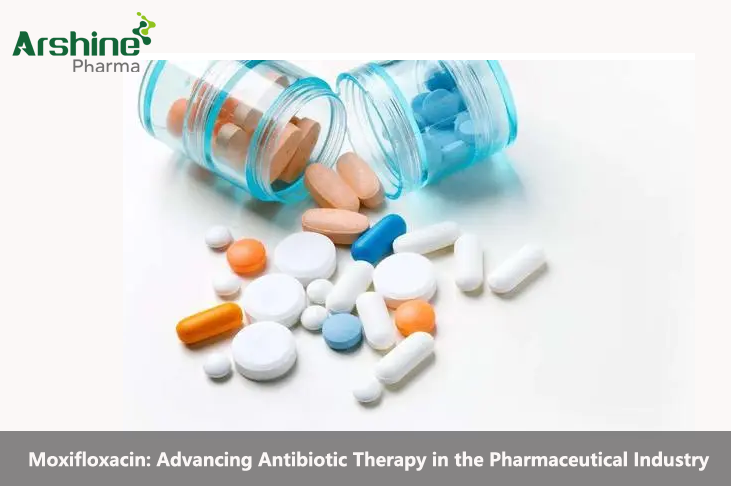
Introduction
In the realm of antibiotic therapy, Moxifloxacin stands as a critical and innovative medication in the pharmaceutical industry. As a member of the fluoroquinolone class, Moxifloxacin has proven to be effective against a wide range of bacterial infections, offering hope in the fight against antimicrobial resistance. This comprehensive analysis explores the characteristics, mechanism of action, pharmacological profile, clinical applications, safety, and future prospects of Moxifloxacin, highlighting its significance in advancing patient care and public health.
1. Characteristics of Moxifloxacin
Moxifloxacin, known under the brand name Avelox, is a synthetic fluoroquinolone antimicrobial agent. It is chemically characterized by a fluorine atom at position 8 and a methoxy group at position 6 of the quinolone core. These structural modifications enhance its activity against both gram-positive and gram-negative bacteria and contribute to its increased potency compared to earlier generations of fluoroquinolones.
2. Mechanism of Action
Moxifloxacin exerts its bactericidal effect through interference with bacterial DNA replication and synthesis. The primary target of Moxifloxacin is DNA gyrase, an essential bacterial enzyme involved in DNA replication. By inhibiting DNA gyrase, Moxifloxacin disrupts the process of DNA unwinding and results in the formation of non-functional DNA, ultimately leading to bacterial cell death.
In addition to DNA gyrase, Moxifloxacin also targets another bacterial enzyme called topoisomerase IV, further enhancing its antibacterial activity against certain gram-positive pathogens.
3. Pharmacological Profile
3.1 Pharmacokinetics
Moxifloxacin is well-absorbed after oral administration, with a bioavailability of approximately 86%. The drug reaches peak plasma concentrations within 1 to 4 hours, depending on the formulation. It exhibits excellent tissue penetration, enabling its effectiveness in both systemic and localized infections.
3.2 Pharmacodynamics
Moxifloxacin demonstrates concentration-dependent bactericidal activity, meaning higher drug concentrations result in more effective bacterial killing. Its extended half-life allows for once-daily dosing, providing convenience and improving patient compliance. Additionally, Moxifloxacin shows low protein binding, contributing to its broad distribution and tissue penetration.
4. Clinical Applications
4.1 Respiratory Tract Infections
Moxifloxacin is widely used in the treatment of respiratory tract infections, including community-acquired pneumonia (CAP) and acute exacerbations of chronic bronchitis (AECB). Its broad spectrum of activity against common respiratory pathogens, including Streptococcus pneumoniae, Haemophilus influenzae, and atypical bacteria like Mycoplasma pneumoniae and Legionella pneumophila, makes it a valuable choice in managing these infections.
4.2 Skin and Soft Tissue Infections
In skin and soft tissue infections, Moxifloxacin has demonstrated efficacy against both gram-positive and gram-negative pathogens, including Staphylococcus aureus (including methicillin-resistant strains) and Escherichia coli. Its ability to penetrate well into skin tissues and achieve high local concentrations contributes to its effectiveness in this setting.
4.3 Intra-Abdominal Infections
Moxifloxacin is also indicated for the treatment of complicated intra-abdominal infections. In combination with other appropriate antimicrobial agents, it can effectively target a broad range of bacterial pathogens commonly associated with intra-abdominal infections, such as Escherichia coli, Bacteroides fragilis, and Enterococcus species.
4.4 Tuberculosis
Moxifloxacin plays an essential role in the treatment of drug-resistant tuberculosis (TB). In combination with other second-line TB drugs, Moxifloxacin contributes to shorter treatment regimens and improved patient outcomes, particularly in cases of multidrug-resistant TB (MDR-TB) and extensively drug-resistant TB (XDR-TB).
5. Safety
Moxifloxacin is generally well-tolerated, with adverse effects typically being mild and transient. Common side effects include nausea, diarrhea, and headache. However, like all fluoroquinolones, Moxifloxacin may be associated with certain safety concerns, such as the risk of tendinitis and tendon rupture, particularly in older adults and those concurrently taking corticosteroids.
6. Future Prospects
The future prospects of Moxifloxacin in the pharmaceutical industry remain promising. As the prevalence of antimicrobial resistance continues to rise, Moxifloxacin's effectiveness against drug-resistant pathogens becomes increasingly valuable. Ongoing research aims to optimize its use in combination therapy and to explore its potential in novel applications, including biofilm-related infections and emerging multidrug-resistant bacterial strains.
Conclusion
Moxifloxacin, a potent fluoroquinolone antibiotic, has established itself as a vital medication in the pharmaceutical industry's efforts to combat bacterial infections and antimicrobial resistance. Its unique characteristics, mechanism of action, and pharmacological profile have positioned it as a versatile agent in the treatment of respiratory tract infections, skin and soft tissue infections, intra-abdominal infections, and drug-resistant tuberculosis.
With a favorable safety profile and ongoing research, Moxifloxacin's future in the pharmaceutical landscape looks promising. As the industry continues to innovate, Moxifloxacin's efficacy against drug-resistant pathogens and its broad spectrum of activity will likely play a crucial role in improving patient outcomes and addressing the global challenge of antimicrobial resistance. Its impact on patient care and public health reaffirms Moxifloxacin's essential role in advancing antibiotic therapy and propels the pharmaceutical industry forward in the relentless pursuit of effective and safe antimicrobial agents.
